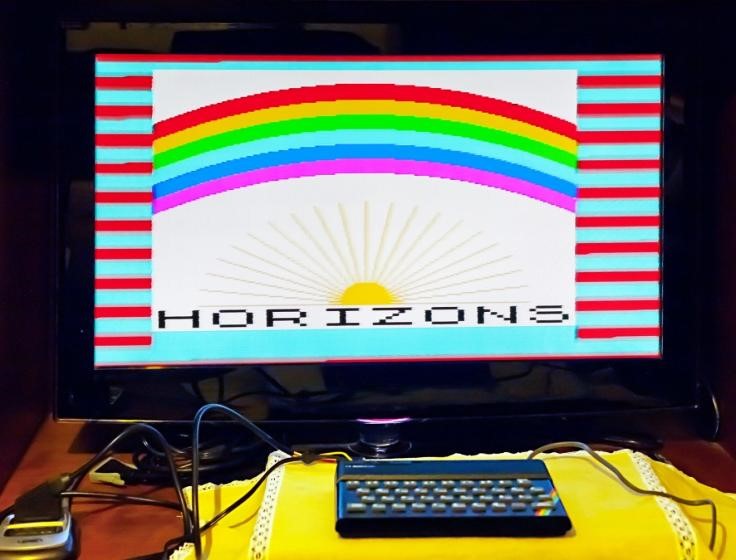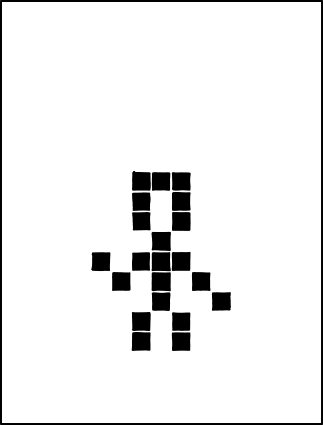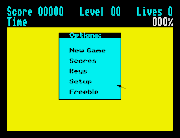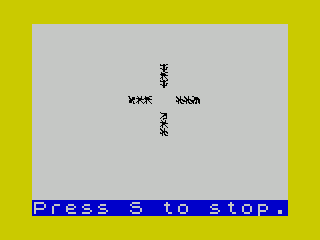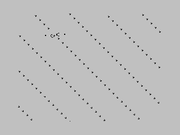The link to archive.org there only has the main text of the article without the source code. So I took the freedom to adapt it to be compilable by zasm
Code: Select all
ORG $8000 ;
UP: DEC H ; Up one pixel (assuming within chr square).
LD A,H ; A:= high part of address.
OR $F8 ; Use only bits 2, 1 and 0.
INC A ;
JR NZ,EXIT ; Jump if within character square,
LD A,L ; A:= low part of address.
SUB $20 ;
LD L,A ; HL:= pix addr, assuming crossed from one
; Screen-third to another
LD A,H ; A:= high part of address.
JR C,TEST_TOP ; Jump if crossed from one third to another.
ADD A,$08 ;
LD H,A ; HL:= pixel address (all remaining cases).
JR EXIT ; Jump to exit,
TEST_TOP: CP $EF ;
JR NZ, EXIT ; Jump unless off top of screen.
LD H,$D7 ; Point HL to bottom line of screen, Note bit
JR EXIT ; 7 of H set for all screen addresses here,
DOWN: INC H ; Down one pixel (assuming within chr square),
LD A,H ; A:= high part of address.
AND $07 ; Use only bits 2, 1 and 0.
JR NZ,EXIT ; Jump if within character square,
LD A,L ; A:= low part of address.
ADD A,$20 ;
LD L,A ; A:= low part of address.
LD A, H ; A:= high part of address.
JR C,TEST_BOTTOM ; Jump if crossed from one third to another,
SUB $08 ;
LD H,A ; HL:= pixel address (all remaining cases).
JR EXIT ; Jump to exit.
TEST_BOTTOM: CP $D8 ;
JR NZ,EXIT ; Jump unless off bottom of screen,
LD H,$C0 ; Point HL to top line of screen,
JR EXIT ; Jump to exit.
LEFT: RLC C ; Left one pixel (assuming within chr square).
JR NC,EXIT ; Jump if within chr square,
LD A,L ; A:= low part of address.
DEC A ; Decrement (to move left).
JR L_R ;
RIGHT: RRC C ; Right one pixel (assuming within chr square).
JR NZ,EXIT ; Jump if within character square,
RIGHT_1: LD A,L ; A:= low part of address.
INC A ; Increment (to move right).
L_R: XOR L ; Combine A and L by taking bits 7, 6 and 5
AND $1F ; of L, and bit 4, 3, 2, 1 and 0 of A.
XOR L ; "This has the effect of ""joining"" the"
LD L,A ; left and right hand edges of the screen,
EXIT: LD A,C ; A:= pixel position within square
AND (HL) ; Test the specified screen pixel.
RET Z ; Return if the pixel in PAPER colour (reset).
INC B ; Otherwise increment count in B register
RET ;
;
ORG $804D ; USR 32845
NEXTGEN: LD HL,$4000 ; Point HL to screen,
LD DE,$C000 ; Point DE to screen copy.
LD BC,$1800 ; BC:=number of bytes in screen.
PUSH DE ; Stack start address of screen copy.
LDIR ; Make copy of screen,
POP HL ; HL points to first byte of screen copy.
LD C,$80 ; C has leftmost pixel set, thus HL and C
; together point to first pixel in the copy.
LOOP: LD B,$00 ; Initialise cell count as zero,
PUSH BC ; Stack pixel position.
PUSH HL ; Stack screen-copy address,
CALL UP;$8000 ; Count, in B, the number of cells which
CALL RIGHT;$803D ; surround the given pixel.
CALL DOWN;$801B ;
CALL DOWN;$801B ;
CALL LEFT;$8035 ;
CALL LEFT;$8035 ;
CALL UP;$8000 ;
CALL UP;$8000 ;
LD A,B ; A:= number of cells surrounding pixel.
POP HL ;
POP BC ; Restore HL and C to point to given pixel,
RES 7,H ; Point HL into screen (rather than copy).
CP $02 ;
JR C,NO_CELL ; Jump if less than two cells surround pixel.
CP 04 ;
JR NC,NO_CELL ; Jump if four or more cells surround pixel.
CP $03 ;
JR NZ,CONTINUE ; Jump if exactly two cells surround pixel
CELL: LD A,C ; A:= pixel position,
OR (HL) ; Prepare to set pixel to create cell,
JR PUT ;
NO_CELL: LD A,C ; A:= pixel position,
CPL ;
AND (HL) ; Prepare to reset pixel to remove cell.
PUT: LD (HL),A ; Set or reset pixel as required,
CONTINUE: SET 7,H ; Point HL back into screen copy.
RRC C ; Right one pixel (assuming within chr square).
JR NC,LOOP ; Jump back if within character square.
CALL RIGHT_1;$8041 ; Right one pixel (otherwise).
LD A,L ; A:= low part of address.
AND $1F ;
JR NZ,LOOP ; Jump back unless off right edge of screen,
CALL DOWN;$801B ; Down one pixel.
LD A,H ; A:= high part of address.
XOR $C0 ;
OR L ;
JR NZ,LOOP ; Jump back unless whole screen done.
RET ;
